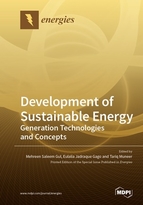Development of Sustainable Energy: Generation Technologies and Concepts
A special issue of Energies (ISSN 1996-1073). This special issue belongs to the section "A: Sustainable Energy".
Deadline for manuscript submissions: closed (30 June 2020) | Viewed by 16837
Special Issue Editors
Interests: energy; sustainable energy; solar energy; hydrogen technologies
Special Issues, Collections and Topics in MDPI journals
Interests: solar PV systems; bifacial PV performance; ground albedo enhancement; sustainable buildings; behaviour and attitude of users towards energy consumption
Special Issues, Collections and Topics in MDPI journals
Interests: renewable energies; energy sustainability; climate change; urban planning
Special Issues, Collections and Topics in MDPI journals
Special Issue Information
Dear Colleagues,
Lack of access to energy supplies and transformation systems is a constraint to human and economic development. Achieving solutions to environmental problems that we face today requires long-term potential actions for sustainable development. Sustainable energy generation should be widely encouraged, as it does not cause any harm to the environment and is widely available free of cost.
Harnessing renewable energy resources appears to be the one of the most efficient and effective solutions. Renewable energy sources such as solar, wind, geothermal, hydropower, biomass and marine energy are at the centre of the transition to less carbon-intensive and more sustainable energy systems. The use of renewable energy through improved technologies and concepts is therefore expected to play a major role in the future of sustainable energy generation.
Energy is central to nearly every major challenge and opportunity the world faces today. Be it for jobs, security, climate change, food production or increasing incomes, access to energy for all is essential. The adoption of the new United Nations Sustainable Development Goals (SDGs) in 2015 marked a new level of political recognition of the importance of energy to development. For the first time, this included a target to ensure access to affordable, reliable, sustainable and modern energy for all—collectively known as Sustainable Development Goal 7, or SDG 7. The aim is to enhance international cooperation by 2030 to facilitate access to clean energy research and technology, including renewable energy, energy efficiency and advanced and cleaner fossil-fuel technology, and to promote investment in energy infrastructure and clean energy technology.
The challenge is, however, far from being solved, and there needs to be more access to clean fuel and technology. Furthermore, more progress needs to be made regarding integrating sustainable energy into end-use applications in sectors such as building, transport and industry.
This edition of the Energies journal addresses the barriers and challenges faced with regards to sustainable energy generation for future energy technologies and concepts, and highlights potential solutions that should lead towards sustainable development.
Prof. Dr. Tariq Muneer
Dr. Mehreen Gul
Prof. Dr. Eulalia Jadraque Gago
Guest Editors
Manuscript Submission Information
Manuscripts should be submitted online at www.mdpi.com by registering and logging in to this website. Once you are registered, click here to go to the submission form. Manuscripts can be submitted until the deadline. All submissions that pass pre-check are peer-reviewed. Accepted papers will be published continuously in the journal (as soon as accepted) and will be listed together on the special issue website. Research articles, review articles as well as short communications are invited. For planned papers, a title and short abstract (about 100 words) can be sent to the Editorial Office for announcement on this website.
Submitted manuscripts should not have been published previously, nor be under consideration for publication elsewhere (except conference proceedings papers). All manuscripts are thoroughly refereed through a single-blind peer-review process. A guide for authors and other relevant information for submission of manuscripts is available on the Instructions for Authors page. Energies is an international peer-reviewed open access semimonthly journal published by MDPI.
Please visit the Instructions for Authors page before submitting a manuscript. The Article Processing Charge (APC) for publication in this open access journal is 2600 CHF (Swiss Francs). Submitted papers should be well formatted and use good English. Authors may use MDPI's English editing service prior to publication or during author revisions.
Keywords
- Energy supplies and transformation
- Sustainable development
- Sustainable energy generation
- Future energy technologies and concepts
- Potential solutions.








